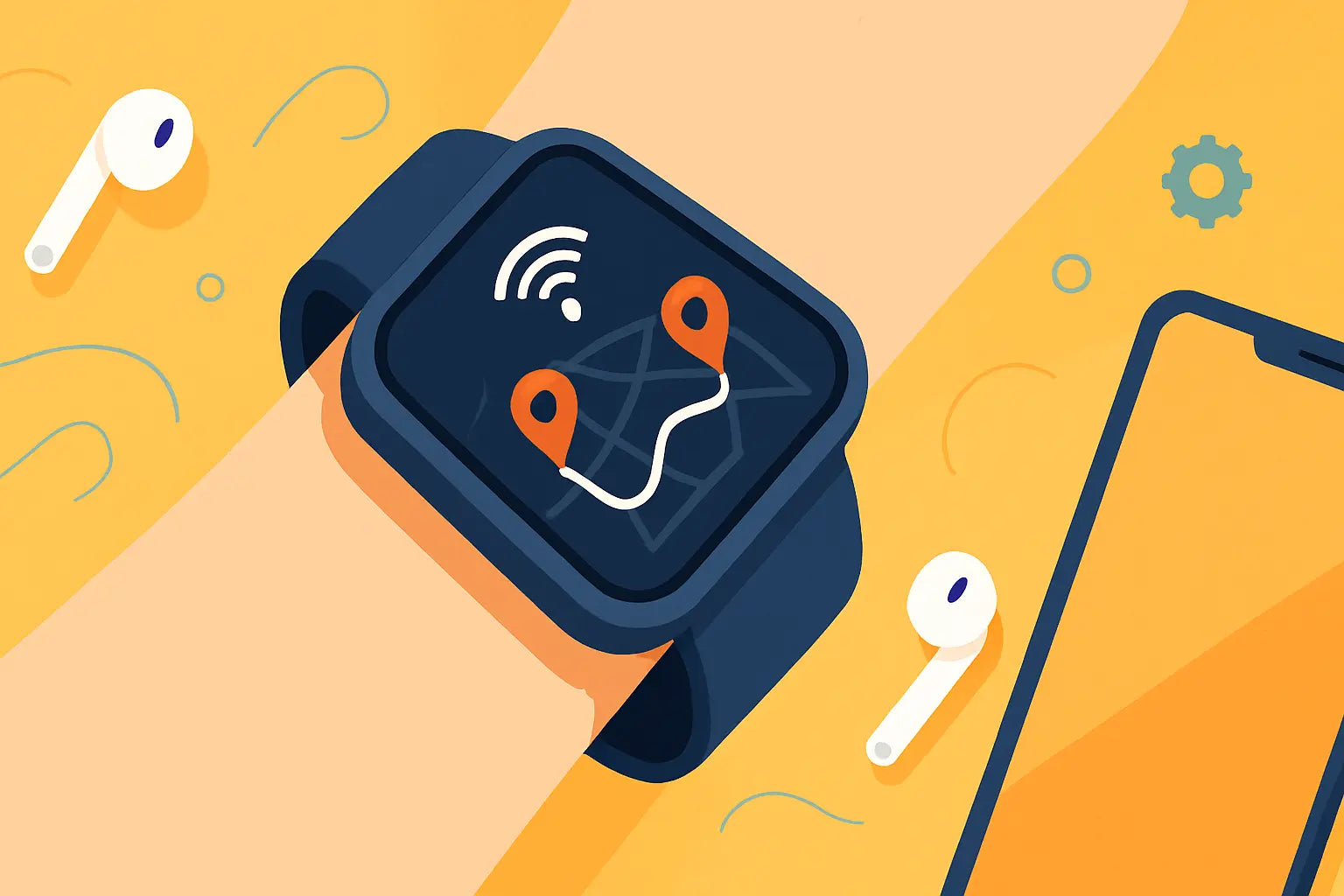Yes, you can usually charge a smartwatch with a phone charger, provided you use the official charging cable or puck and a certified USB power adapter. Most watches regulate their own power draw and accept USB-C PD or 5V USB-A sources. Avoid no-name high-voltage adapters and unverified magnetic chargers.
The quick rule and the power basics
A phone charger is typically safe because the smartwatch and its charging puck regulate the incoming power. The charger only supplies what the watch requests through USB or USB-C Power Delivery. Compatibility depends more on the cable or puck than the wall adapter.
Voltage, current, and wattage made simple
USB-A ports normally provide 5V at up to 2A, which is 10W. USB-C PD adapters can negotiate 5V, 9V, 12V, 15V, and more, but the watch puck usually requests 5V. Most smartwatches draw between 1W and 5W, far below the headline rating of a modern phone charger.
Smart charging chips limit risk
The charging puck and the watch contain control circuits that cap current and manage heat. Apple Watch 11 fast charging is roughly up to 5W with the Apple USB-C fast charge cable. Samsung Galaxy Watch 8 and Galaxy Watch 9 typically draw about 5W during normal charging.
Can you charge smartwatch with USB-C phone charger?
Yes, a USB-C PD phone charger from 5W to 30W works well when you use the manufacturer’s cable. An Apple 20W USB-C adapter will safely power the Apple Watch 11 fast charge puck. A 25W Samsung USB-C adapter will safely power the Galaxy Watch 9 puck at the watch’s own limited draw.
Higher wattage does not push more power into the watch. The puck requests what it needs during PD or USB negotiation. A 65W GaN laptop charger is fine because the watch only consumes low single-digit watts.
Is it safe to use phone charger for smartwatch?
It is safe if the charger is certified and you use the correct official or MFi or manufacturer-approved cable. Look for compliance logos like USB-IF, CE, UL, or ETL. Avoid suspicious bricks that advertise unrealistic outputs or lack safety marks.
Normal charging surface temperatures of a smartwatch sit around warm to the touch, commonly below 42 C during fast charging. If you notice persistent high heat, stop and inspect the cable and adapter. Heat is the primary factor that accelerates battery wear.
Brand-specific guidance
Apple Watch 11
Use the Apple USB-C fast charge cable for best results. With a 20W USB-C adapter, Apple Watch 11 can go from 0 to around 80 percent in about 45 minutes. Larger adapters like 30W to 96W also work, but the watch still caps at its designed power draw.
Samsung Galaxy Watch 8 and Samsung Galaxy Watch 9
Use the official Samsung magnetic puck, powered by a USB-C PD or AFC charger. A 15W or 25W Samsung adapter is ideal, even though the watch typically draws around 5W. Expect slower wireless top ups compared to phones because the watch optimizes for battery longevity.
Other common platforms
Many Garmin and Fitbit models use proprietary pin cables that convert 5V input down to safe charging levels. Always use the original or brand-approved cable, even if the wall charger is generic. Do not attempt to charge with a random magnetic pad that is not designed for your watch.
Reverse charging with a phone
Samsung Wireless PowerShare and Android
Some Android phones offer reverse wireless charging that can top up compatible watches. Expect a slow rate around 2.5W to 4.5W, which is suitable for emergency boosts. Alignment is critical, so reposition the watch if charging stops.
MagSafe and Apple Watch specifics
iPhone does not natively reverse charge Apple Watch. Use a USB-C adapter, USB-C power bank, or a laptop’s USB-C port with the Apple puck. A compact USB-C power bank often provides the most convenient travel solution.
Fast chargers, GaN, and multi-port adapters
GaN chargers are efficient and run cooler at the wall for the same wattage. Multi-port chargers can power a watch and phone at the same time without harming either device. The watch still negotiates low-watt power and is protected by onboard safeguards.
Cable choice matters more than the brick
Your watch’s cable or puck dictates compatibility and speed far more than the adapter. Apple Watch uses a proprietary magnetic fast charge puck, while many Samsung watches use a WPC-based magnetic puck tuned for wearables. Mixing pucks across brands rarely works and can interrupt charging or increase heat.
For style and fit, explore Apple Watch straps and pair them with practical Apple Watch accessories for daily use. Quality bands and stands help reduce wear on the cable. A stable stand can improve airflow during charging.
Charger type comparison and smartwatch compatibility
| Charger type | Nominal output | Protocol | Apple Watch 11 | Galaxy Watch 9 | Notes |
|---|---|---|---|---|---|
| USB-A 5W cube | 5V 1A | USB BC 1.2 | Works with Apple puck | Works with Samsung puck | Slow but safe |
| USB-A 10W cube | 5V 2A | USB BC 1.2 | Works, near full speed | Works, near full speed | Common travel option |
| USB-C 20W PD | 5V to 9V | USB-C PD | Works, fast charge | Works at 5W draw | Ideal everyday choice |
| USB-C 30W GaN | 5V to 20V | USB-C PD | Works, runs cool | Works, runs cool | Great multi-device use |
| Laptop 65W port | 5V to 20V | USB-C PD | Works via Apple puck | Works via Samsung puck | Draw limited by puck |
| Unknown no-name brick | Claimed 30W+ | Unknown | Avoid for safety | Avoid for safety | Lacks certifications |
Charging from laptops, cars, and planes
USB-A ports on aircraft seats and older cars usually supply 5V at 0.5A to 1A. This is enough to trickle charge through the official puck. Newer car adapters with USB-C PD offer faster, stable power for watches.
- Use official cable
- Check safety marks
- Avoid hot dashboards
- Keep vents clear
- Do not stack devices
Best practices and common myths
Battery health tips
Frequent small top ups are better for lithium cells than deep discharges. A 20 to 80 percent routine is a practical daily target. Occasional full cycles for calibration are fine.
Heat is the real enemy
Place the puck on a hard, cool surface to reduce heat. Remove thick protective cases during charging to improve airflow. If the watch feels hot, pause charging and let it cool.
Nightstand setup and cable care
Use a stand that supports the puck without bending the cable. Avoid sharp cable angles that strain the connector over time. Periodically clean the watch back and puck to remove dust.
FAQ
Can I use my 45W phone charger?
Yes, the watch will only draw a few watts through the correct cable. The higher rating does not force extra power into the battery. Ensure the charger is certified and reputable.
Will a cheap USB hub work?
Many passive hubs limit current to 0.5A. That can interrupt charging or make it extremely slow. Prefer a powered hub or plug the puck directly into a wall adapter.
Can I charge Apple Watch 11 with a laptop?
Yes, plug the Apple USB-C fast charge cable into the laptop’s USB-C port. The watch will negotiate 5V and charge normally. Charging speed is similar to a standard 5W to 20W wall brick.
Can I use a Qi phone pad?
Most smartwatches do not charge on generic phone Qi pads. Apple Watch needs its magnetic puck, and Samsung watches need the Samsung puck. Use the manufacturer’s accessory for reliability.
Is overnight charging bad?
It is generally fine due to built-in protections. The watch tapers current and may pause to manage heat and longevity. If heat concerns you, remove cases and charge on a cooler surface.
Conclusion
Yes, you can charge a smartwatch with a phone charger as long as you use the official charging cable or puck and a certified adapter. The watch will regulate power and draw only what it needs. Prioritize reputable chargers and the correct cable for safe, efficient charging every time.




Leave a comment
All comments are moderated before being published.
This site is protected by hCaptcha and the hCaptcha Privacy Policy and Terms of Service apply.